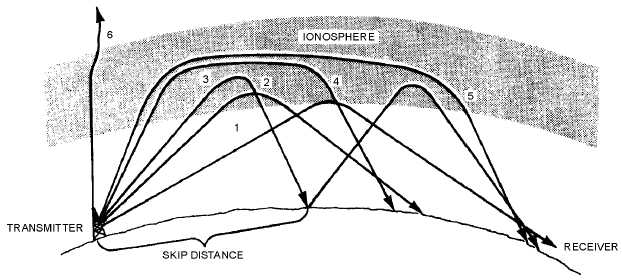2-25
may also, reach the receiving antenna over a path involving more than one layer, by multiple hops
between the ionosphere and Earth, or by any combination of these paths.
Figure 2-20 shows how radio waves may reach a receiver via several paths through one layer. The
various angles at which rf energy strikes the layer are represented by dark lines and designated as rays 1
through 6.
Figure 2-20.—Ray paths for a fixed frequency with varying angles of incidence.
When the angle is relatively low with respect to the horizon (ray 1), there is only slight penetration of
the layer and the propagation path is long. When the angle of incidence is increased (rays 2 and 3), the
rays penetrate deeper into the layer but the range of these rays decreases. When a certain angle is reached
(ray 3), the penetration of the layer and rate of refraction are such that the ray is first returned to Earth at a
minimal distance from the transmitter. Notice, however, that ray 3 still manages to reach the receiving site
on its second refraction (called a hop) from the ionospheric layer.
As the angle is increased still more (rays 4 and 5), the rf energy penetrates the central area of
maximum ionization of the layer. These rays are refracted rather slowly and are eventually returned to
Earth at great distances. As the angle approaches vertical incidence (ray 6), the ray is not returned at all,
but passes on through the layer.
ABSORPTION IN THE IONOSPHERE
Many factors affect a radio wave in its path between the transmitting and receiving sites. The factor
that has the greatest adverse effect on radio waves is ABSORPTION. Absorption results in the loss of
energy of a radio wave and has a pronounced effect on both the strength of received signals and the
ability to communicate over long distances.
You learned earlier in the section on ground waves that surface waves suffer most of their absorption
losses because of ground-induced voltage. Sky waves, on the other hand, suffer most of their absorption
losses because of conditions in the ionosphere. Note that some absorption of sky waves may also occur at
lower atmospheric levels because of the presence of water and water vapor. However, this becomes
important only at frequencies above 10,000 megahertz.

